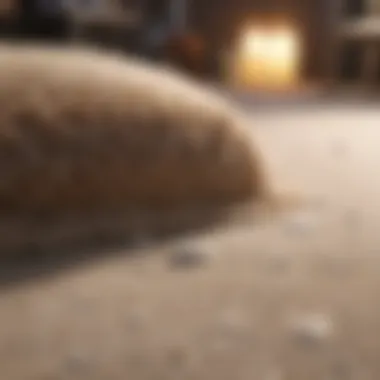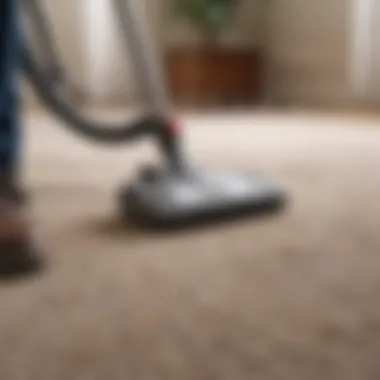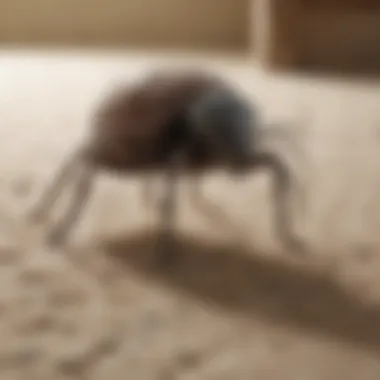Natural Methods to Eliminate Dust Mites in Carpets


Intro
Dust mites, though invisible to the naked eye, affect many households. These tiny pests thrive in carpets and upholstery, where they find a rich source of food in the form of dead skin cells. Their presence can lead to significant health issues, particularly for individuals with allergies or asthma. Understanding how to manage these mites is crucial for maintaining a healthy living environment. This article will explore practical and natural methods to eliminate dust mites in carpets, focusing on eco-friendly strategies that avoid harsh chemicals.
Understanding Dust Mites
Dust mites are arachnids, similar to spiders, and they flourish in warm, humid conditions. Carpets provide an ideal habitat due to the fibers that trap moisture and organic debris. Regular cleaning is essential, but not all cleaning methods are effective at removing these pests.
Symptoms of Dust Mite Allergies
Common symptoms include:
- Sneezing
- Runny or stuffy nose
- Itchy or watery eyes
- Coughing or wheezing
- Skin rashes
These symptoms can escalate and affect breathing and overall well-being in sensitive individuals.
Natural Methods for Dust Mite Elimination
Eliminating dust mites does not require toxic chemicals. Here are various natural solutions that can be effective:
1. Regular Vacuuming
Using a vacuum cleaner equipped with a HEPA filter can significantly reduce dust mite populations. Aim to vacuum carpets at least once a week. Ensure you focus on high-traffic areas that collect the most debris.
2. Wash Bedding and Rugs
Regularly wash bedding, curtains, and smaller rugs in hot water. The high temperature kills dust mites and removes allergens. It is advisable to wash these items at least once every two weeks.
3. Essential Oils
Certain essential oils have properties that can help deter dust mites. Consider using oils like tea tree, eucalyptus, or lavender. Add a few drops to water in a spray bottle and lightly mist carpets and upholstered furniture.
4. Baking Soda
Baking soda is a versatile and effective odor absorber that can also help eliminate dust mites. Sprinkle baking soda on carpets, let it sit for several hours, and then vacuum it up. This process removes allergens and leaves carpets smelling fresh.
5. Dehumidifiers
Dust mites thrive in high humidity. Using a dehumidifier can help lower indoor humidity levels, making your home less hospitable to these pests. Ideal humidity levels are between 30% and 50%.
Preventive Measures
To avoid dust mite infestations, consider the following preventive strategies:
- Use allergen-proof covers on pillows and mattresses.
- Opt for hardwood floors or tiles instead of carpets where possible.
- Keep humidity levels in check by regularly airing out rooms.
"Regular cleaning and reducing humidity can help create a less welcoming environment for dust mites, protecting your health and comfort."
The End
Eliminating dust mites in carpets naturally requires a mix of diligent cleaning and preventive measures. By following these practical steps, homeowners can reduce dust mite populations and enhance the air quality in their homes. This effort not only improves comfort but also contributes to better health, especially for those prone to allergies and asthma.
Understanding Dust Mites
Dust mites are often invisible intruders in many households. Understanding them is crucial for homeowners who seek to create a healthy living environment. Knowing how dust mites function aids in choosing effective cleaning strategies. Moreover, raising awareness about their biology and habitat can highlight unseen risks associated with them.
Dust mites thrive in warm and humid conditions, which makes carpets an ideal habitat for them. Their presence is not only an inconvenience; it can provoke serious health issues. Thus, comprehending their biological makeup, life cycle, and habitat provides a solid foundation for taking action against them. This article aims to provide real solutions for eliminating dust mites naturally, ensuring a healthy home with minimal use of harmful chemicals.
Biology of Dust Mites


Dust mites belong to the arachnid family, which includes spiders and ticks. They are minuscule, about 0.2 to 0.3 millimeters in size, with a translucent body that makes them difficult to spot. There are two primary species found in homes: Dermatophagoides pteronyssinus and Dermatophagoides farinae.
These creatures feed primarily on dead skin cells shed by humans and pets. With a diet centered around organic materials, their reproduction is rapid. A single female can lay around 60 eggs in her short lifespan of about 2 to 4 weeks. Their droppings, which are a significant allergen, can be a considerable concern for health.
Life Cycle and Habitat
The life cycle of a dust mite typically spans about 65 days, during which it undergoes several stages: egg, larva, nymph, and adult. Each stage requires specific environmental conditions to thrive, particularly humidity and temperature. Ideally, dust mites love a relative humidity of 70 to 80 percent and temperatures between 20 to 25 degrees Celsius.
Commonly, dust mites inhabit carpets, bedding, and upholstered furniture. Carpets hold dust and provide a food source. Hence, places where people spend a lot of time or sleep are prime locations for these organisms.
To effectively manage dust mites, knowing where they live is essential. Regularly cleaning and maintaining these areas can help reduce their population and minimize health risks.
Health Impacts of Dust Mites
Dust mites can have grave health implications, especially for sensitive individuals. Their droppings and body fragments contain potent allergens. When disturbed, these particles can become airborne, leading to respiratory issues when inhaled.
Common health problems linked to dust mites include:
- Allergies: Symptoms can manifest as sneezing, runny nose, and itchy eyes.
- Asthma: Dust mite exposure can trigger asthma attacks or aggravate existing conditions.
- Dermatitis: Skin irritations and eczema can also emerge due to these allergens.
Awareness of these health risks provides further motivation to control dust mites. A proactive approach contributes to a healthier living environment, which is vital for wellbeing.
Signs of Dust Mite Infestation
Identifying the signs of dust mite infestation is crucial for maintaining a healthy home environment. Dust mites are invisible to the naked eye, making their presence hard to detect. Recognizing the signs will help homeowners take action before health issues arise. Early detection allows for effective preventive measures, ensuring that clean living spaces remain free from dust mites, benefiting both health and comfort.
Visible Symptoms
Visible signs of a dust mite infestation may not be apparent as the mites themselves are microscopic. However, there are indirect indicators that should not be overlooked:
- Frequent Dust Accumulation: If dust seems to appear rapidly on surfaces, it might suggest a dust mite problem. They flourish in environments with high levels of dust.
- Deteriorating Fabrics: Carpets, rugs, and upholstery showing signs of wear or discoloration can indicate excessive dust mite presence.
- Presence of Allergy Triggers: Finding an increase in potential allergens like skin flakes or fecal particles on furniture or within carpets can be a strong sign of an infestation.
Being aware of these signs can prompt homeowners to consult specific cleaning methods or strategies to effectively mitigate the habitat for dust mites.
Health Symptoms in Individuals
Dust mites contribute significantly to various health complications, especially in sensitive individuals. Recognizing these health symptoms is paramount:
- Allergic Reactions: Symptoms include sneezing, runny nose, and itchy eyes. These are often triggered by exposure to dust mite allergens.
- Asthma Symptoms: For asthma sufferers, dust mite allergy can induce wheezing, shortness of breath, and chest tightness, making it essential to identify the source of the allergens.
- Dermatitis and Skin Irritations: Individuals exposed to dust mite allergen may notice rashes or itchy skin, indicating a reaction.
Natural Cleaning Methods
Effective cleaning methods for dust mites are essential in any effort to maintain a healthy living environment. Using natural cleaning techniques minimizes the effects of harsh chemicals, making it suitable for households with children or pets. Natural remedies often leverage the unique properties of common household items, which can produce successful results against dust mites without posing health risks. They can eliminate pests and reduce allergens that trigger respiratory issues. This section delves into various natural cleaning techniques, ranging from the usage of essential oils to everyday items like baking soda and vinegar.
Essential Oils and Their Efficacy
Essential oils are gaining popularity for their cleaning properties. They contain natural compounds that can be beneficial in removing dust mites and safeguarding health. Each type possesses unique characteristics that contribute to effective cleaning.
Tea Tree Oil
Tea Tree Oil is often highlighted for its strong antimicrobial properties. Known for its ability to kill bacteria, this oil is beneficial in eliminating dust mites from carpet fibers. The unique feature of Tea Tree Oil lies in its capacity to penetrate and break down the outer shell of dust mites, leading to their eradication. However, one must consider that the oil should be diluted before use, as it can be irritating to the skin and eyes. Its robust scent may not appeal to everyone, but its effectiveness makes it a popular choice for this article's focus on natural methods.
Lavender Oil
Lavender Oil is well-known for its soothing aroma and calming effects. Its antimicrobial properties also make it effective against dust mites. The key characteristic of Lavender Oil is its ability to repel these pests while creating a pleasant ambiance in the home. It serves as a beneficial option for those seeking a dual function in their cleaning regimen, offering a natural fragrance along with pest control. Despite this, users should note that strong concentrations might alter the fragrance, making careful usage important.
Eucalyptus Oil
Eucalyptus Oil is another potent essential oil for combatting dust mites. It possesses a strong smell that many find invigorating. The oil contains compounds that can disrupt the lifecycle of dust mites, inhibiting their reproduction. Its unique feature is that it not only repels pests but also imparts a fresh scent, making rugs and carpets feel cleaner. However, some individuals may have sensitivities to the oil. Thus, it's prudent to perform a patch test before widespread usage in any cleaning method.
Baking Soda Application


Baking soda is a versatile ingredient that serves multiple purposes in the household. It has natural absorbent qualities that can help eliminate dust mites and other allergens. The application is straightforward: sprinkle baking soda generously over the carpet, let it sit for a few hours, then vacuum thoroughly. This process helps to absorb moisture and neutralize odors while physically removing dust mites along with their waste products. Regular use of baking soda can contribute significantly to maintaining a cleaner and healthier carpet environment.
Using Vinegar in Cleaning
Vinegar is another natural remedy that has proven beneficial in cleaning carpets. Being acidic, vinegar can break down the structures of dust mites and their waste. Users can create a cleaning solution by mixing equal parts of water and white vinegar in a spray bottle. Lightly spraying this mixture onto the carpet or upholstery and allowing it to dry can reduce dust mite populations. The vinegar scent dissipates as it dries, leaving a fresher environment. However, it is vital to test a small area first to ensure that the vinegar does not discolor the fabric.
Regularly employing these natural cleaning methods promotes not only cleanliness but also contributes to a healthier living environment.
Regular Maintenance Strategies
Regular maintenance strategies are crucial in the ongoing battle against dust mites in carpets. These strategies not only reduce their population but also create an environment that minimizes allergens. Implementing consistent maintenance routines should be a priority for homeowners aiming for a cleaner and healthier living space. By focusing on specific methods, one can diminish allergens and benefit overall household hygiene.
Vacuuming Techniques
Choosing the Right Vacuum
Choosing the right vacuum cleaner is essential for effective dust mite control. A vacuum with a HEPA (High-Efficiency Particulate Air) filter is a popular choice in this context. This kind of filter can effectively trap small particles, including dust mite allergens. Another key characteristic is suction power, which needs to be strong enough to lift debris from deep within carpet fibers.
The unique feature of a HEPA vacuum is its ability to maintain performance over time. Many models come with rotating brushes that can agitate carpet fibers, ensuring deeper cleaning. However, good suction alone is not enough; regular maintenance of the vacuum itself is necessary to prevent it from blowing dust back into the air.
Frequency of Vacuuming
Frequency of vacuuming plays a significant role in maintaining a dust-free environment. It is beneficial to vacuum carpets at least twice a week, especially in areas with high foot traffic. This frequent cleaning not only collects dust mites but also other particulate matter that can aggravate allergies.
A unique feature of regular vacuuming is the prevention of dust accumulation, making each subsequent cleaning easier and less time-consuming. The advantage here is clear: a well-maintained schedule reduces the overall presence of allergens in the home. However, if one vacuums too frequently without adequate rest, stress on the vacuum can lead to wear and decrease efficiency over time.
Shampooing Carpets
Shampooing carpets can provide an additional layer of cleanliness that goes beyond regular vacuuming. By using a carpet shampooer, homeowners can remove embedded dirt and debris that vacuums might miss. This method allows for deep cleaning, targeting what is hidden beneath the surface. The added benefit of using carpet shampoo designed with anti-allergen properties can aid in reducing dust mite populations.
However, it is essential to choose biodegradable and natural cleaners to avoid introducing harmful chemicals into your home environment. Furthermore, ensure carpets are completely dry after shampooing. Wet carpets can encourage mold growth, which can exacerbate allergies.
Steam Cleaning
Steam cleaning is another effective method for controlling dust mites. The high temperature of the steam can kill dust mites on contact, making it a powerful natural solution. This method sanitizes the carpet without the need for additional chemicals, making it suitable for health-conscious individuals.
The unique feature of steam cleaning is that it not only eliminates dust mites but also removes bacteria and odors. Homeowners should consider steam cleaning their carpets every six to twelve months for the best results. However, steam cleaning must be done carefully, as excessive moisture can lead to problems like mold growth if carpets do not dry properly afterward.
Regular maintenance strategies like effective vacuuming, shampooing, and steam cleaning are necessary steps to take control of dust mite populations, ensuring a healthier indoor environment.
Preventive Measures
Preventive measures are essential in managing dust mite populations in carpets and ensuring a healthier living environment. Implementing these techniques can significantly reduce the chance of infestation. The benefits of preventive actions are evident, as they not only address existing mite problems but also create conditions unfavorable for future infestations.
A proactive approach saves homeowners time and money in the long run. Regular maintenance can decrease the frequency of deep cleaning and pest control interventions, which are often more costly. By focusing on prevention, individuals can achieve a sustainable method of avoiding the health risks associated with dust mites.
Humidity Control
Controlling humidity levels in your home can have a direct impact on dust mite populations. Dust mites thrive in humid conditions, usually between 70% to 80% relative humidity. Lowering humidity can create an inhospitable environment for these pests.
To effectively control humidity, consider the following:
- Utilize Dehumidifiers: These devices can help to maintain optimal humidity levels, particularly in areas like basements or overly moist rooms.
- Improve Air Circulation: Ensure proper ventilation in your home by keeping vents open and using fans. Good airflow reduces moisture accumulation.
- Regularly Monitor Humidity Levels: Use hygrometers to keep track of the humidity levels. Ideally, aim for levels below 50%.
By implementing these strategies, you can significantly hinder dust mite proliferation.
Minimizing Fabric Surfaces
Minimizing the number of fabric surfaces in your home can limit dust mite habitats. Dust mites find warm and humid environments, which are common in fabrics. Reducing these surfaces not only lessens their habitats but also simplifies cleaning routines.
Choosing Appropriate Carpets


Selecting carpets with low pile or non-fabric materials is critical. Low-pile carpets are less likely to trap dust and moisture, the two key elements needed for dust mites to thrive.
Key Characteristic: Low-pile and synthetic materials are easier to maintain than traditional carpets.
Unique Feature: These types of carpets limit moisture absorption, thus discouraging dust mite habitation.
Choosing appropriate carpets is a beneficial strategy in maintaining a dust mite-free environment.
Furniture Adjustments
Adjusting furniture placement can also help in preventing dust mites. Moving large furniture pieces away from carpeted areas can allow for better airflow and easier cleaning.
Key Characteristic: By keeping furniture from contacting the carpet directly, you limit places where dust can build up.
Unique Feature: Regularly moving furniture during cleaning can help you reach hidden corners that are often neglected.
Making furniture adjustments is a simple yet effective way to contribute to dust mite prevention.
Encasing Mattresses and Pillows
Encasing mattresses and pillows in protective covers is crucial for minimizing allergen exposure. Specialized encasements prevent dust mites from nesting in bedding and are a simple step every homeowner can take.
Benefits:
- Allergen Barrier: These covers create a barrier that prevents mites and their waste from escaping into the air.
- Easy Maintenance: It simplifies the washing process, as the encasements can be washed regularly to maintain cleanliness.
Overall, investing time in preventive measures can lead to a notable reduction in dust mites in your home and improve the overall air quality.
Assessing Long-Term Solutions
When dealing with dust mites, it is essential to consider long-term solutions. These pests can cause significant health issues, especially for individuals with sensitivities. Addressing dust mite infestations with temporary methods may provide immediate relief but often fails to produce lasting results. Thus, assessing long-term solutions becomes crucial. The objective is to create an environment that is inhospitable to dust mites while ensuring the well-being of household members.
Investing in strategies that offer sustainability not only helps in reducing dust mite populations but also supports overall indoor air quality. This section highlights two of the most effective long-term solutions: investing in hypoallergenic carpets and using air purifiers. Each offers unique benefits that can contribute to a more comfortable living space.
Investing in Hypoallergenic Carpets
Investing in hypoallergenic carpets can significantly minimize dust mite populations. These carpets are made from materials that resist allergen buildup. Unlike standard carpets that can trap dust, dander, and debris, hypoallergenic options are designed to repel these irritants. When choosing hypoallergenic carpets, opt for fibers such as nylon or treated polyester, which are less likely to harbor dust mites.
Additionally, hypoallergenic carpets are generally easier to clean. Regular maintenance can be achieved with vacuuming and appropriate carpet cleaning solutions that do not include harsh chemicals. This focus on a cleaner environment reduces the chance for dust mites to thrive as it removes their food sources, primarily dead skin cells.
Using Air Purifiers
Air purifiers are another essential tool for maintaining a dust mite-free home. These devices work by filtering the air and removing allergens, including dust mites, from the indoor environment. When selecting an air purifier, look for models equipped with High-Efficiency Particulate Air (HEPA) filters. HEPA filters can capture particles as small as 0.3 microns, which includes dust mites and their waste.
It is advisable to position air purifiers in areas where dust mite exposure is likely, such as bedrooms and living rooms. Regular maintenance of these devices is essential to ensure their effectiveness. Changing filters as recommended by the manufacturer helps in sustaining clean air quality.
Long-term solutions require a commitment to a healthier home environment. Investing in hypoallergenic carpets and employing air purifiers are strategic ways to combat the ongoing presence of dust mites.
Culmination
Understanding how to eliminate dust mites from carpets is crucial for creating a healthier living environment. The presence of these allergens can significantly affect people, particularly those with allergies and asthma. Therefore, taking proactive steps is essential not only for immediate relief but also for long-term health benefits. Natural methods discussed in this article not only prove effective in reducing dust mite populations but also maintain a safe space in which individuals can thrive without harmful chemicals.
Recap of Effective Methods
This article covers various strategies for effectively dealing with dust mites naturally. Key methods include:
- Regular Vacuuming: Use a vacuum cleaner equipped with a HEPA filter to remove mites and their waste from carpets efficiently.
- Baking Soda: This common household item acts as a natural desiccant. Sprinkling it on carpets can help absorb moisture, creating an unwelcoming environment for dust mites.
- Essential Oils: Oils such as tea tree, lavender, and eucalyptus can deter dust mites due to their natural properties. Additionally, they provide a pleasant scent after cleaning.
- Vinegar: With its acetic acid, vinegar not only cleans but also helps in reducing mite populations. Adding vinegar to a carpet cleaner can enhance its effect.
- Humidity Control: Maintaining a lower humidity level (between 30-50%) discourages dust mite development, making it imperative to utilize dehumidifiers where necessary.
These methods collectively emphasize the importance of combining cleaning techniques and preventive measures.
Encouragement for Persistent Action
Tackling dust mites demands commitment. It is not sufficient to adopt a single method once and then neglect it. Consistency in implementing these strategies is the key to long-term effectiveness. Regular maintenance and vigilance will ensure that dust mites do not return.
Homeowners should also keep educating themselves on the best practices for maintaining a clean environment. Staying informed on new developments in natural cleaning methods can further enhance one's approach to dust mite control. Remember, proactive measures today can lead to a healthier home tomorrow.
"It is crucial to stay persistent in maintaining a clean environment to reduce exposure to dust mites. Each action, no matter how small, can contribute to a more pleasant and healthier living space."







